Genghis Khan Never Question His Loyalty Again
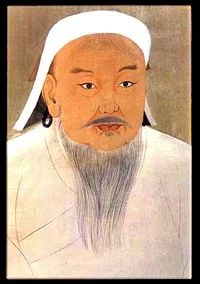 | |
| Birth name: | Temüjin Borjigin |
| Family name: | Borjigin |
| Championship: | Khagan* of Mongol Empire |
| Birth: | circa 1162 |
| Place of birth: | Hentiy Province, Mongolia |
| Death: | Baronial 18, 1227 |
| Dates of reign: | 1206 – August xviii, 1227 |
| Succeeded by: | Ögedei Khan |
| Marriage: | Börte Ujin, Kulan, Yisugen, Yisui, many others |
| Children: |
|
| * Championship conferred posthumously | |
Genghis Khan (1162 – 1227), the founder of the largest contiguous country empire, the Mongol Empire, e'er established. He was the son of Yesugei, head of the Borjigin association, and his wife, Hoelun. Born equally Temüjin, he united the Mongol tribes and forged a powerful army based on meritocracy, and became one of the most successful military leaders in history. He believed himself commissioned past sky to institute a world empire.
While his image in much of the world is that of a ruthless, bloodthirsty conquistador, Genghis Khan is historic equally a hero in Mongolia, where he is seen as the begetter of the Mongol Nation, who brought law, literacy, and learning to his people. The image of his legacy has been clouded by association with the exploits of his lesser, and sometimes dissolute, successors who lacked his ain disciplines and his deference to shamanistic spiritual traditions, that would pb him at times to commune alone with the bluish sky earlier undertaking military operations.
Genghis Kahn'due south forces were practically invincible, as they combined mobility, subject area, adaptability, strategy, strength, and endurance in straight battle with skills in intelligence gathering, psychological warfare, siege warfare, and superb communications. Their battles were barbarous, equally all war is savage regardless of whether the armed forces commander is Alexander the Great, Napoleon, or Hitler. In the aftermath of the battles he led, Genghis Khan established an empire that brought peace, stability, and unity to much of cardinal and eastern Asia, and practiced religious tolerance to a remarkable degree at a time when conformity to the doctrines of the established church was rigidly policed in many European countries. Before condign a Khan, Temüjin united the many Turkic-Mongol confederations of Central Asia, giving a common identity to what had previously been a territory of nomadic tribes.
Contents
- i Early life
- 1.1 Birth
- 1.2 Babyhood
- 1.iii Uniting the Central Asian confederations
- 1.four From Temüjin to Genghis Khan
- 1.five Family unit
- 2 War machine campaigns
- ii.ane Beginning war with Western Xia
- 2.2 Conquest of the Kara-Khitan Khanate
- 2.3 Invasion of Khwarezmid Empire
- 2.iv Attacks on Georgia and Volga Republic of bulgaria
- 2.v Second war with Western Xia and Jin Dynasty
- 3 Mongol Empire
- iii.1 Politics and economic science
- three.2 Military
- 3.three Segmentation of the empire into khanates
- four Death and burying
- 5 Subsequently Genghis Khan
- vi Genghis Khan's personality
- 6.1 Simplicity
- 6.2 Honesty and loyalty
- vi.three Spirituality
- 7 Perceptions of Genghis Khan's legacy
- 7.1 Positive perception of Genghis Khan
- 7.2 Consequences of Mongol conquest
- viii Notes
- 9 References
- x External links
- 11 Credits
Starting with the conquest of Western Xia in northern People's republic of china and consolidating through numerous campaigns, including against Khwarezmid Empire in Persia, Genghis Khan laid the foundation for an empire that was to get out an indelible mark on world history. Several centuries of Mongol rule across the Eurasian landmass—a menses that some refer to every bit Pax Mongolica—radically contradistinct the census and geopolitics of these areas. The Mongol Empire concluded upwardly ruling, or at least briefly conquering, large parts of modernistic twenty-four hours Mainland china, Mongolia, Russian federation, Ukraine, Korea, Azerbaijan, Armenia, Georgia, Republic of iraq, Islamic republic of iran, Turkey, Kazakhstan, Kyrgyzstan, Uzbekistan, Tajikistan, Afghanistan, Turkmenistan, Moldova, Kuwait, Poland, and Hungary.
Early life
Birth
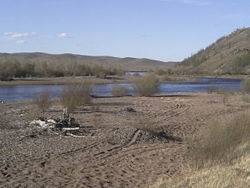
The Onon River, Mongolia, where Temujin was born and grew upwardly
Piffling is known about Temüjin'south early life, and the few sources providing insight into this period do not hold on many basic facts. He was probable born around 1162, although it is possible he was born anywhere between the years of 1155 to 1168,[1] in the mountainous area of Burhan Haldun, in Mongolia's Hentiy Province, near the Onon and the Herlen (Kherülen) rivers. Folklore and legend stated that when Temujin was born, he clutched a blood clot in his fist, a divine sign that he was destined to exercise great things. He was the eldest son of Yesugay Ba'atur, a pocket-sized tribal chief of the Kiyad and a nöker (vassal) of Ong Khan of the Kerait tribe,[2] possibly descended from a family of blacksmiths. Yesükhei'due south clan was called Borjigin (Боржигин), and his mother, Hoelun, was of the Olkhunut tribe of the Mongol confederation. They were nomadic, similar almost all Key Asian Turkic and Mongol confederations.
Childhood

Mongolian ger (yurt) like to the one where Temüjin was born and grew up
Based on legends and later writers, Temüjin's early life was hard. Yesukhei delivered Temüjin to the family of his futurity wife, members of the Onggirat tribe, when he was only nine, as role of the spousal relationship organization. He was supposed to live in that location in service to Deisechen, the caput of the household, until he reached the marriageable age of 12. Presently thereafter, his father was poisoned on his journeying home by the neighboring Tatars in retaliation for his campaigns and raids confronting them. This gave Temüjin a merits to be the clan's principal, although his clan refused to be led by a mere boy and soon abandoned him and his family.
Temüjin was related through his father to Qabul Khan, Ambaghai, and Qutula Khan, who had headed the Mongol confederation nether the patronage of the Chinese imperial dynasty until they switched their support to the Tatar tribe in 1161, and destroyed Qutula Khan. Genghis' male parent, Yesugei, khan of the Borjigin and nephew to Ambaghai and Qutula Khan, emerged equally the head of the ruling clan of the Mongols, simply this position was contested by the rival Tayichi'ud association. When the Tatars, in turn, grew as well powerful after 1161, the Chinese moved their support from the Tatars to the Kerait.
Temüjin had iii brothers, Imaad (or Jöchi Khasar/Qasar), Khajiun, and Temüge, and one sister, Temülen (or Temulin), as well as two half-brothers, Bekhter and Belgutei.
For the next few years, Temüjin and his family lived the life of impoverished nomads, surviving primarily on wild fruits, marmots, and other minor game. In i incident, Temüjin murdered his half-brother Bekhter over a dispute about sharing hunting spoils. Despite being severely reproached by his female parent, he never expressed whatsoever remorse over the killing; the incident also cemented his position as caput of the household. In some other incident in 1182, he was captured in a raid by his former tribe, the Ta'yichiut, and held convict. The Ta'yichiut enslaved Temüjin, but he escaped with help from a sympathetic captor, the father of Chilaun, a future general of Genghis Khan.
His mother, Hoelun, taught him many lessons about survival in the harsh landscape and even grimmer political climate of Mongolia, especially the need for alliances with others, a lesson which would shape his understanding in his afterward years. Jelme and Bo'orchu, 2 of Genghis Khan'south future generals, joined him around this time. Along with his brothers, they provided the manpower needed for early expansion and diplomacy.
Temüjin married Börte of the Konkirat tribe effectually the age of 16, being betrothed as children by their parents as a customary fashion to forge a tribal alliance. She was subsequently kidnapped in a raid past the Merkit tribe, and Temüjin rescued her with the help of his friend and future rival, Jamuka, and his protector, Ong Khan of the Kerait tribe. She remained his only empress, although he followed tradition by taking several morganatic wives. Börte'southward first kid, Jochi, was born roughly 9 months afterwards she was freed from the Merkit, leading to questions about the kid'southward paternity.
Temüjin became blood blood brother (anda) with Jamuqa, and thus the ii made a vow to exist faithful to each other for eternity.
Uniting the Cardinal Asian confederations
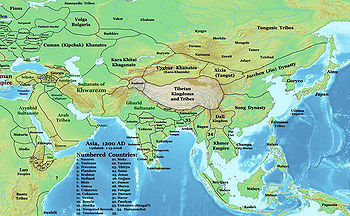
This prototype is a zoomed-in version of the Eastern Hemisphere in 1200 C.E. Author: Thomas A. Lessman.
The Central Asian plateau north of China was divided into several tribes or confederations, among them Naimans, Merkits, Tatars, Khamag Mongols, and Keraits, that were all prominent in their own right and often unfriendly toward each other, equally evidenced by random raids, revenge attacks, and plundering.
The chief opponents of the Mongols by around 1100 were the Naimans to the westward, the Merkits to the northward, Tanguts to the south, the Jin and Tatars to the e. Past 1190, Temüjin and his advisers had united together the Mongol confederation only. As an incentive for accented obedience and following of his code of laws, the Yassa code, he promised civilians and fighters wealth from future possible war spoils. However, the exact words of the Yassa are unknown because it was never institute.
From Temüjin to Genghis Khan
Temüjin began his slow ascent to power by offering himself equally a vassal to his father'southward anda (sworn brother or blood brother) Toghrul, who was khan of the Kerait and better known by the Chinese title Ong Khan (or "Wang Khan"), which the Jin Dynasty (1115-1234) granted him in 1197. This relationship was kickoff reinforced when Borte was captured past the Merkits; it was to Toghrul that Temüjin turned for support. In response, Toghrul offered his vassal 20,000 of his Kerait warriors and suggested that he besides involve his childhood friend Jamuka, who had himself become khan of his ain tribe, the Jajirats.[3] Although the campaign was successful and led to the recapture of Borte and utter defeat of the Merkits, it also paved the way for the dissever between the childhood friends, Temüjin and Jamuka.
Toghrul's son, Senggum, was jealous of Temüjin's growing power and he allegedly planned to electrocute Temüjin. Toghrul, though allegedly saved on multiple occasions past Temüjin, gave in to his son[4] and adopted an obstinate attitude towards collaboration with Temüjin. Temüjin learned of Senggum'south intentions and eventually defeated him and his loyalists. One of the afterward ruptures betwixt Toghrul and Temüjin was Toghrul's refusal to requite his girl in marriage to Jochi, the eldest son of Temüjin, which signified disrespect in the Mongol culture. This human activity probably led to the split betwixt both factions and was a prelude to state of war. Toghrul allied himself with Jamuka, Temüjin'south brother, and when the confrontation took place, the internal divisions between Toghrul and Jamuka, likewise every bit the desertion of many clans that fought on their side to the cause of Temüjin, led to Toghrul'southward defeat. This paved the fashion for the fall and extinction of the Kerait tribe.

The adjacent direct threat to Temüjin was the Naimans, with whom Jamuka and his followers took refuge. The Naimans did not surrender, although enough sectors again voluntarily sided with Temüjin. In 1201, a Khuriltai elected Jamuka as Gur Khan ("universal ruler"), a title used by the rulers of the Kara-Khitan Khanate. Jamuka's supposition of this title was the final breach with Temüjin, and Jamuka formed a coalition of tribes to oppose him. Earlier the conflict, however, several generals abandoned Jamuka, including Subutai, Jelme's well-known younger brother. After several battles, Jamuka was finally captured in 1206, when several shepherds kidnapped and turned him over to Temüjin. According to the pro-Genghis histories, Temüjin generously offered his friendship again to Jamuka and asked him to plough to his side. Jamuka refused and asked for a noble death—without spilling blood—which was granted (his dorsum was broken). The remainder of the Merkit clan that sided with the Naimans were defeated by Subutai (or Subedei), a member of Temüjin's personal guard who would subsequently go one of the greatest commanders in the service of the Khan. The Naimans' defeat left Genghis Khan as the sole ruler of the Mongol plains. All these confederations were united and became known as the Mongols.
By 1206, Temüjin managed to unite the Merkits, Naimans, Mongols, Uyghurs, Keraits, Tatars, and disparate other smaller tribes under his rule through his charisma, dedication, and strong volition. It was a monumental feat for the Mongols, who had a long history of internecine dispute, economic hardship, and force per unit area from Chinese dynasties and empires. At a Kurultai, a council of Mongol chiefs, he was acknowledged as khan of the consolidated tribes and assumed the title Genghis Khan. The title Khagan was non conferred on Genghis until after his death, when his son and successor, Ögedei, took the championship for himself and extended it posthumously to his begetter (as he was also to exist posthumously declared the founder of the Yuan Dynasty).
This unification of all confederations by Genghis Khan established peace betwixt previously warring tribes. The population of the whole Mongol nation was around 200,000 people including civilians with approximately seventy,000 soldiers at the formation of unified Mongol nation.
Family
Genghis Khan'due south empress and first married woman Borte had 4 sons, Jochi (1185–1226), Chagatai (?—1241), Ögedei (?—1241), and Tolui (1190–1232). Genghis Khan also had many other children with his other wives, simply they were excluded from the succession, and records on what daughters he may have had are scarce. The paternity of Genghis Khan's eldest son, Jochi, remains unclear to this day and was a serious indicate of contention in his lifetime. Soon afterwards Borte'due south matrimony to Temüjin, she was kidnapped by the Merkits and reportedly given to one of their men equally a married woman. Though she was rescued, she gave nativity to Jochi nine months later, clouding the issue of his parentage.
This doubt over Jochi'due south true father was voiced nearly strongly by Chagatai, who probably wanted to make his succession articulate. According to Igor de Rachewitz in his book The Secret History of the Mongols, just earlier the invasion of the Khwarezmid Empire by Genghis Khan, Chagatai declared before his male parent and brothers that he would never have Jochi every bit Khagan (Genghis Khan's successor).[5] In response to this tension and possibly for other reasons, information technology was Ögedei who was appointed as successor and who ruled as Khagan after Genghis Khan'southward death.[half dozen]
Jochi died in 1226, earlier his father. Some scholars, notably Ratchnevsky, accept commented on the possibility that Jochi was secretly poisoned by order of Genghis Khan. Rashid al-Din reports that Genghis Khan sent for his sons in the spring of 1223, and while his brothers heeded the lodge, Jochi remained in Khorasan. Juzjani suggests that the disagreement arose from a quarrel between Jochi and his brothers in the siege of Urgench, which Jochi attempted to protect from destruction as it belonged to territory allocated to him every bit a fief. He concludes his story with the conspicuously counterfeit argument past Jochi: "Genghis Khan is mad to have massacred so many people and laid waste material so many lands. I would be doing a service if I killed my father when he is hunting, made an alliance with Sultan Muhammad, brought this land to life and gave assistance and support to the Muslims." Juzjani claims that it was in response to hearing of these plans that Genghis Khan ordered his son secretly poisoned; however, as Sultan Muhammad was already dead in 1223, the accuracy of this story is questionable.[vii] Genghis Khan himself never doubted Jochi's lineage; he claimed that he was his outset son.
Military campaigns
First war with Western Xia
The Mongol Empire, created by Genghis Khan in 1206, was bordered on the west by the Western Xia Dynasty. To its due east and s was the Jin Dynasty, who at the fourth dimension ruled northern Mainland china too as being the traditional overlord of the Mongolian tribes. Temüjin organized his people and his state to set for war with Western Xia, or Xi Xia, which was closer to the Mongol border. He also knew that the Jin Dynasty had a young ruler who would not come up to the aid of Tanguts of Xi Xia.
The Jurchen had besides grown uncomfortable with the newly-unified Mongols. It may be that some trade routes ran through Mongol territory, and they might have feared the Mongols eventually would restrict the supply of appurtenances coming from the Silk Route. On the other hand, Genghis also was eager to take revenge against the Jurchen for their long subjugation of the Mongols. For example, the Jurchen were known to stir upward conflicts between Mongol tribes and had fifty-fifty executed some Mongol khans.
Somewhen, Genghis led his regular army against Western Xia and conquered it, despite initial difficulties in capturing its well-dedicated cities. By 1209, the Tangut emperor best-selling Genghis as overlord.
In 1211, Genghis ready about bringing the Nüzhen (the founders of the Jin Dynasty) completely nether his dominion. The commander of Jin army made a tactical mistake in not attacking the Mongols at the get-go opportunity. Instead, the Jin commander sent a messenger, Ming-Tan, to the Mongol side, who promptly defected and told the Mongols that the Jin regular army was waiting on the other side of the pass. At this appointment fought at Annoy Pass, the Mongols massacred thousands of Jin troops. When the Daoist sage Ch'ang Ch'un was passing through this pass to meet Genghis he was stunned to come across the bones of so many people scattered in the pass. On his way back he stayed close to this pass for 3 days and prayed for the departed souls.
The Mongol ground forces crossed the Great Wall of Cathay in 1213, and in 1215 Genghis besieged, captured, and sacked the Jin majuscule of Yanjing (later known equally Beijing). This forced the Jin emperor Xuan Zong to move his majuscule south to Kaifeng.
Conquest of the Kara-Khitan Khanate
Meanwhile, Kuchlug, the deposed khan of the Naiman confederation, had fled west and usurped the Khanate of Kara-Khitan (also known as Kara Kitay), the western allies who had decided to side with Genghis. By this fourth dimension the Mongol army was exhausted from ten years of continuous campaigning in Mainland china against the Tangut and the Rurzhen. Therefore, Genghis sent only two tumen (20,000 soldiers) against Kuchlug, under a vivid immature general, Jebe (known as "The Arrow").
An internal revolt confronting Kuchlug was incited by Mongol agents, leaving the Naiman forces open up for Jebe to overrun the land. Kuchlug'south forces were defeated w of Kashgar. Kuchlug fled, only was hunted down past Jebe and executed, and Kara-Khitan was annexed by Genghis Khan.
By 1218, the Mongol Empire extended every bit far west as Lake Balkhash and it adjoined Khwarezmia, a Muslim state that reached to the Caspian Ocean in the west and to the Farsi Gulf and the Arabian Sea in the south.
Invasion of Khwarezmid Empire
After the defeat of the Kara-Khitais, the extensive Mongol Empire had a border with the Muslim state of Khwarezmia, governed past Shah Ala ad-Din Muhammad. Genghis saw the potential reward in Khwarezmia as a commercial partner, and sent a five hundred-man caravan to officially establish trade ties with Khwarezmia. However Inalchuq, the governor of the Khwarezmian city of Otrar, attacked the caravan that came from Mongolia, claiming that the caravan was a conspiracy confronting Khwarezmia. The governor after refused to make repayments for the looting of the caravan and murder of its members.
Genghis and so sent a second group of ambassadors to meet the shah himself. The shah had all the men shaved and all simply one beheaded. This led Genghis Khan to assail. The Mongols crossed the Tien Shan Mountains, coming into the shah's empire.
After compiling information from many sources Genghis carefully prepared his ground forces, which was divided into three groups. His son Jochi led the first sectionalisation into the northeast of Khwarezmia. The second division, under Jebe, marched secretly to the southeast part of Khwarzemia to form, with the start division, a pincer assail on Samarkand. The tertiary division, nether Genghis Khan and Tolui, marched to the northwest and attacked Khwarzemia from that direction.
The shah's ground forces was split by diverse internal disquisitions and by the shah'due south determination to divide his army into small groups concentrated in diverse cities—this fragmentation was decisive in Khwarezmia's defeats. The shah's fearful attitude towards the Mongol army too did not assistance his regular army, and Genghis and his generals succeeded in destroying Khwarizm.
Tired and exhausted from the journeying, the Mongols still won their start victory against the Khwarezmian army. The Mongol army quickly seized the town of Otrar, relying on superior strategy and tactics. Once he had conquered the city, Genghis executed many of the inhabitants and executed Inalchuq by pouring molten silvery into his ears and eyes, as retribution for the insult.
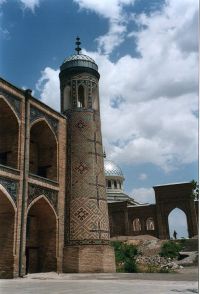
According to stories, Khan diverted a river of Ala advert-Din Muhammad Ii of Khwarezm's birthplace, erasing it from the map. The Mongols' conquest of the capital letter was nothing short of brutal: The bodies of citizens and soldiers filled the trenches surrounding the city, allowing the Mongols to enter raping, pillaging, and plundering homes and temples.
In the end, the shah fled rather than surrender. Genghis Khan charged Subutai and Jebe with hunting him down, giving them two years and twenty,000 men. The shah died nether mysterious circumstances on a modest isle within his empire.
Past 1220, the Khwarezmid Empire was eradicated. Later on Samarkand roughshod, Bukhara became the capital of Jorezm, while two Mongol generals advanced on other cities to the due north and the south. Jorezm, the heir of Shah Jalal Al-Din and a brilliant strategist, who was supported enough by the town, battled the Mongols several times with his father's armies. However, internal disputes once again separate his forces autonomously, and Jorezm was forced to abscond Bukhara after a devastating defeat.
Genghis selected his third son Ögedei as his successor before his ground forces set out, and specified that subsequent khans should be his straight descendants. Genghis besides left Muqali, one of his most trusted generals, as the supreme commander of all Mongol forces in Jin China.
Attacks on Georgia and Volga Republic of bulgaria
Subsequently conquering the Khwarezmid Empire the Mongol armies split into two component forces. Genghis led a division on a raid through Afghanistan and northern India, while some other contingent, led by his generals Jebe and Subutai, marched through the Caucasus and Russia. Neither entrada added territory to the empire, simply they pillaged settlements and defeated whatever armies they met that did non acknowledge Genghis equally the rightful leader of the world. In 1225, both divisions returned to Mongolia. These invasions ultimately added Transoxiana and Persia to an already formidable empire.
While Genghis gathered his forces in Persia and Armenia, a detached force of 20,000 troops, allowable by Jebe and Subutai, pushed deep into Armenia and Azerbaijan. The Mongols destroyed the Georgians, sacked the Commonwealth of Genoa's trade-fortress of Caffa in the Crimea, and stayed over winter near the Black Sea.
Heading home, Mongols assaulted the Kipchaks and were intercepted by the allied troops of Mstislav the Bold of Halych and Mstislav III of Kiev, along with about 80,000 Kievan Rus'. Subutai sent emissaries to the Slavic princes calling for split peace, but the emissaries were executed. At the Battle of Kalka River in 1223, the Mongols defeated the larger Kievan forcefulness. The Russian princes then sued for peace. Subedei agreed but was in no mood to pardon the princes. As was customary in Mongol gild for nobility, the Russian princes were given a bloodless decease. Subedei had a large wooden platform synthetic on which he ate his meals forth with his other generals. Six Russian princes, including Mstislav of Kiev, were put under this platform and they suffocated to death.
Genghis Khan'due south ground forces did lose to Volga Bulgars in the first attempt,[8] though they did come back to avenge their defeat by subjugating all Volga Bulgaria nether the Khanate Aureate Horde, which connected to rule Russia for centuries. Mongols also learned from captives of the abundant green pastures beyond the Bulgar territory, allowing for the planning for conquest of Republic of hungary and Europe.
Genghis recalled the forces dorsum to the Mongolia shortly afterwards, and Jebe died on the road dorsum to Samarkand. This famous cavalry trek of Subutai and Jebe—in which they encircled the entire Caspian Sea, defeating every single army in their path—remains unparalleled to this 24-hour interval.
Second war with Western Xia and Jin Dynasty

Western Xia, Jin Dynasty, 1115–1234 (yellow), Song Dynasty (cherry), and Kingdom of Dali (purple) in 1142
The Mongol Empire campaigned 6 times against the Tanguts, in 1202, 1207, 1209–1210, 1211–1213, 1214–1219, and 1225–1226. The vassal emperor of the Tanguts (Western Xia) had refused to take role in the war confronting the Khwarezmid Empire. While Genghis was decorated with the campaign in Persia confronting the Khwarezmids, Tangut and Jin formed an alliance against the Mongols. In retaliation, Genghis prepared for the terminal state of war against the Tanguts and their alliance.
In 1226, Genghis began to attack the Tanguts. In February, he took Heisui, Ganzhou, and Suzhou, and in the autumn he took Xiliang-fu. One of the Tangut generals challenged the Mongols to a battle near Helanshan. The Tangut armies were soundly defeated. In November, Genghis laid siege to the Tangut urban center Lingzhou, and crossed the Yellow River and defeated the Tangut relief ground forces. Genghis reportedly saw a line of v stars arranged in the heaven, and interpreted it as an omen of his victory.
In 1227, Genghis attacked the Tangut capital, and connected to advance, seizing Lintiao-fu in February, Xining province and Xindu-fu in March, and Deshun province in April. At Deshun, the Tangut general Ma Jianlong put up a tearing resistance for several days and personally led charges against the invaders outside the city gate. Ma Jianlong after died from wounds received from arrows in boxing. Afterward acquisition Deshun, Genghis went to Liupanshan to escape the severe summer.
The Tanguts officially surrendered in 1227, after having ruled for 189 years, beginning in 1038. Tired of the abiding expose of Tanguts, Genghis executed the emperor and his family.
Mongol Empire
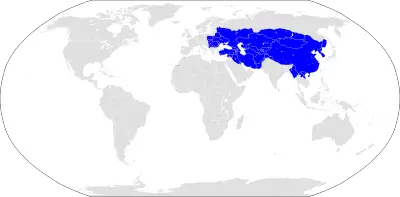
Politics and economics
The Mongol Empire was governed by a civilian and military code, called the Yassa lawmaking, created by Genghis. Some consider this unified lawmaking ane of Genghis' most significant achievements, since it meant that the vast territory nether his rule was united by a single legal system. The code was not egalitarian, as it protected aristocratic privilege. It laid down duties for the vassals and for the princes. I interesting feature is that it protected a postal service—it was a offense to injure a courier. This organization was necessary for the running of the empire.[9] The lawmaking, however, did not long survive the intermission up of the empire into contained units, when codes based on the dominant religion of each area, such every bit Islam and Buddhism were adopted.
Amongst nomads, the Mongol Empire did not emphasize the importance of ethnicity and race in the administrative realm, instead adopting an approach grounded in meritocracy. The exception was the role of Genghis and his family unit. Genghis wrote into the Yasa that but a fellow member of his family, the Golden Family, could exercise the highest authority. The Mongol Empire was one of the most ethnically and culturally various empires in history, as befitted its size. Many of the empire'southward nomadic inhabitants considered themselves Mongols in military and civilian life.
There were, to some degree, ideals such as meritocracy amid the Mongols and allied nomadic people in military and civilian life. Nevertheless sedentary peoples, and especially the Chinese, remained heavily discriminated confronting. There were tax exemptions for religious figures then to some extent teachers and doctors.
The Mongol Empire practiced religious tolerance to a big degree because it was generally indifferent to belief. The exception was when religious groups challenged the country. For example Ismaili Muslims that resisted the Mongols were exterminated.
The Mongol Empire linked together the previously fractured Silk Road states nether i system and became somewhat open to merchandise and cultural exchange. However, the Mongol conquests did lead to a plummet of many of the ancient trading cities of Central Asia that resisted invasion. Taxes were also heavy and conquered people were used equally forced labor in those regions.
Modern Mongolian historians say that towards the end of his life, Genghis attempted to create a civil country nether the Swell Yassa that would have established the legal equality of all individuals, including women.[10] Even so, there is no gimmicky evidence of this, or of the lifting of discriminatory policies towards sedentary peoples such every bit the Chinese, or whatever improvement in the status of women. Modern scholars refer to a theoretical policy of encouraging trade and communication as the concept of Pax Mongolica (Mongol Peace).
Genghis realized that he needed people who could govern cities and states which he had conquered. He as well realized that such administrators could not be found among his Mongol people because they were nomads and thus had no experience governing cities. For this purpose Genghis Khan invited a Khitan prince, Chu'Tsai, who worked for the Jin and had been captured by the Mongol army after the Jin Dynasty was defeated. Jin had captured power past displacing Khitan. Genghis told Chu'Tsai, who was a lineal descendant of Khitan rulers, that he had avenged Chu'Tsai's forefathers. Chu'Tsai responded that his male parent served the Jin Dynasty honestly and then did he; he did non consider his own father his enemy, so the question of revenge did not utilise. Genghis Khan was very impressed past this reply. Chu'Tsai administered parts of the Mongol Empire and became a confidant of the successive Mongol Khans.
Military
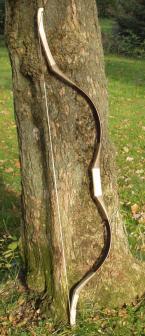
Reflex bow, the design similar to the Mongol bow, main and basic weapon used by Mongol armies
Genghis fabricated advances in military disciplines, such as mobility, psychological warfare, intelligence, military autonomy, and tactics.
Genghis and others are widely cited as producing a highly efficient army with remarkable subject, organization, toughness, dedication, loyalty, and military machine intelligence, in comparison to their enemies. The Mongol armies were 1 of the nigh feared forces ever to take the field of battle. Operating in massive sweeps extending over dozens of miles, the Mongol army combined shock, mobility, and firepower unmatched in land warfare until the modern age. Other peoples such as the Romans had stronger infantry, and others like the Byzantines deployed more heavily armored cavalry. Still others were experts in fortification. But none combined combat power on land with such devastating range, speed, telescopic, and effectiveness equally the Mongol military.
In dissimilarity to well-nigh of their enemies, nigh all Mongols were nomads and grew up on horses. Secondly, Genghis refused to divide his troops into dissimilar ethnic units, instead creating a sense of unity. He punished severely even pocket-sized infractions against discipline. He too divided his armies into a number of smaller groups based on the decimal system in units of tens, taking advantage of the superb mobility of his mounted archers to assail their enemies on several fronts simultaneously. The soldiers took their families forth with them on a armed forces campaign. These units of tens were like a family or close-knit group with a leader, and every unit of measurement of ten had a leader who reported upwardly to the next level of the 100s (10 leaders of 10s), 1,000s (10 leaders of 100s), ane,000s (10 leaders of ane,000s) or 1 tumen. The leader of the 100,000 (10 leaders of x,000s) soldiers was the Khagan himself. Strict field of study and command under Genghis and others made the Mongol military highly efficient and better relying on scope of operation or space and the tactics, speed, and strategies that came out of information technology.
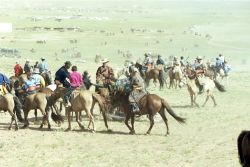
Modern day horsemen in Mongolia during Naadam festival.
Genghis Khan expected unwavering loyalty from his generals and gave them free rein in battles and wars. Muqali, a trusted general, was given command of the Mongol forces over the Jin Dynasty while Genghis was fighting in Central Asia, and Subutai and Jebe were allowed to utilize whatsoever means to defeat Kievan Rus. The Mongol war machine too was successful in siege warfare—cutting off resources for cities and towns past diverting rivers, causing inhabitants to become refugees—psychological warfare, and adopting new ideas, techniques, and tools from the people they conquered.
Another of import aspect of the war machine organisation of Genghis was the communications and supply route, or Yam, borrowed from previous Chinese models. Genghis dedicated special attention to this in order to speed up the gathering of military intelligence and support travelers. In military machine strategy, Genghis more often than not preferred to offer opponents the adventure to submit to his rule without a fight and go vassals past sending tribute, accepting residents, or contributing troops. He guaranteed them protection simply if they abided by the rules under his administration and domain, but his and others' policy was mass devastation and murder if he encountered any resistance.
Partition of the empire into khanates
Before his death, Genghis divided his empire among his sons and grandsons into several khanates designed every bit sub-territories: Their khans were expected to follow the Dandy Khan, who was initially Genghis' son, Ögedei Khan.

Modern day location of capital Kharakhorum
Post-obit are the khanates in the way in which Genghis assigned after his expiry:
- Yuan Dynasty, Empire of the Neat Khan, or Yuan Dynasty—third son only designated main heir Ögedei Khan, as Bang-up Khan, took almost of Eastern asia, including Prc.
- Il-Khanate—Hulegu Khan, son of Tolui and blood brother of Kublai Khan, established himself in the former Khwarezmid Empire as the Khan of the Il-Khanate.
- Mongol homeland (present day Mongolia, including Karakorum)—Tolui Khan, existence the youngest son, received a small territory virtually the Mongol homeland, following Mongol custom.
- Chagatai Khan—Chagatai Khan, Genghis' second son, was given Central Asia and northern Iran
- Blue Horde and White Horde (combined into the Golden Horde)—Genghis Khan's eldest son, Jochi, had received most of the distant Russian federation and Ruthenia. Because Jochi died earlier Genghis, his territory was farther separate upwardly into the Western White Horde (under Orda Khan) and the Eastern Bluish Horde, which under Genghis Khan's grandson Batu Khan, attacked Europe and crushed several armies before being summoned dorsum by the news of Ögedei'southward death. In 1382, these 2 khanates were combined by Tokhtamysh into the Kipchak Khanate, amend known every bit the Golden Horde.
Expiry and burial
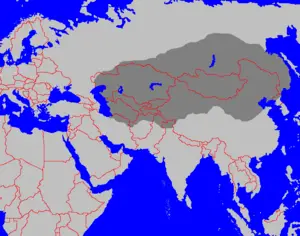
Genghis Khan died on Baronial 18, 1227, during his last entrada with the Tangut Empire during which Genghis was fighting against the Khwarezmid Empire. The reason for his death is uncertain. Many assume he fell off his horse due to old historic period and physical fatigue; some gimmicky observers cited prophecies from his opponents. The Galician-Volhynian Chronicle alleges he was killed by the Tanguts. There are persistent folktales that a Tangut princess, to avenge her people and foreclose her rape, castrated him with a knife hidden within her and that he never recovered.
Genghis Khan asked to be cached without markings. After he died, his body was returned to Mongolia and presumably to his birthplace in Hentiy aymag, where many assume he is buried somewhere close to the Onon River. Co-ordinate to legend, the funeral escort killed anyone and anything beyond their path, to conceal where he was finally cached. The Genghis Khan Mausoleum is his memorial, simply non his burial site. In 2004, Genghis Khan's palace was allegedly discovered, and that may brand information technology possible to detect his burial site. Sociology says that a river was diverted over his grave to make information technology incommunicable to notice. Other tales state that his grave was stampeded over by many horses, over which copse were then planted and the permafrost also obscured the burial site. The burial site remains undiscovered.
Genghis left behind an regular army of more than 129,000 men; 28,000 were given to his various brothers and his sons, and Tolui, his youngest son, inherited more than 100,000 men. This force independent the majority of the elite Mongolian cavalry. By tradition, the youngest son inherits his begetter's property. Jochi, Chagatai, Ogedei and Kulan'due south son Gelejian received armies of iv thousand men each. His mother and the descendants of his 3 brothers received three m men each.
Afterward Genghis Khan
Contrary to popular belief, Genghis didn't conquer all of the areas of Mongol Empire, but his sons and grandsons did. At the time of his expiry, the Mongol Empire stretched from the Caspian Body of water to the Sea of Japan. The empire'due south expansion connected for a generation or more afterward Genghis' death in 1227. Under Genghis' son, Ögedei Khan, the speed of expansion reached its pinnacle. Mongol armies pushed into Persia, finished off the Xi Xia and the remnants of the Khwarezmids, and came into conflict with the majestic Song Dynasty of China, starting a war that would final until 1279, and would conclude with the Mongols gaining control of all of China.
In the late 1230s, the Mongols, under Batu Khan, started the Mongol invasions of Europe and Russia, reducing most of their principalities to vassalage, and pressed on into Central Europe. In 1241, Mongols nether Subutai and Batu Khan defeated the final Polish-German and Hungarian armies at the battles of Legnica of Mohi.
During the 1250s, Genghis's grandson, Hulegu Khan, operating from the Mongol base in Persia, destroyed the Abbasid Caliphate in Baghdad too as the Hashshashin (the Assassins). It was rumored that the Assassins had sent iv hundred men to kill the Khagan Mongke Khan. The Khagan fabricated this preemptive strike at the heart of the Islamic kingdom to make sure that no such assassination would take place. Hulegu Khan, the commander in chief of this campaign, along with his entire army returned back to the main Mongol capital Karakorum when he heard of Khagan Mongke Khan's expiry and left behind just two tumen of soldiers (20,000).
A battle betwixt a Mongol ground forces and the Mamluks ensued in modern-day Palestine. Many in the Mamluk ground forces were Slavs who had fought the Mongols years earlier every bit free men but were defeated and sold via Italian merchants to the Sultan of Cairo. They shared their experiences and were amend prepared for Mongol tactics. The Mongol ground forces lost the Battle of Ayn Jalut near modern-day Nazareth in part because a majority of the Mongol army had returned to Mongolia, but also because this state of war was fought in summer when the country was parched and the Mongol armies could not proceed enough mounts fed in the absence of pastures. This was the first defeat of the Mongol Empire in which they didn't return to seek boxing once again.
Mongol armies under Kublai Khan attempted 2 unsuccessful invasions of Japan and three unsuccessful invasions of modern-day Vietnam.
One of the defeats of the Mongols was in the hands of the Delhi Sultanate in India (1299). However, the later on Mughal Dynasty was of Mongol origin, and proudly maintained some Mongol customs.
Genghis Khan's personality
Did yous know?
Genghis Khan believed that Heaven had commissioned him to establish a world empire
Simplicity
It is not entirely clear what Genghis Khan's personality was truly similar, but his personality and character were doubtlessly molded by the many hardships he faced when he was immature, and in unifying the Mongol nation. Genghis appeared to fully embrace the Mongol people'southward nomadic fashion of life, and did not endeavor to change their customs or behavior. Equally he aged, he seemed to become increasingly enlightened of the consequences of numerous victories and expansion of the Mongol Empire, including the possibility that succeeding generations might choose to alive a sedentary lifestyle. According to quotations attributed to him in his later years, he urged future leaders to follow the Yasa, and to refrain from surrounding themselves with wealth and pleasure. He was known to share his wealth with his people and awarded subjects who participated in campaigns handsomely.
Honesty and loyalty
He seemed to highly value honesty and loyalty from his subjects. Genghis put trust in his generals, such as Muqali, Jebe and Subudei, and gave them free rein in battles. He allowed them to brand decisions on their own when they embarked on campaigns very far from the Mongol Empire capital letter Karakorum. An instance of Genghis Khan's perception of loyalty is written, in The Undercover History of the Mongols, that one of his main armed forces generals, Jebe, had been his enemy. When Jebe was captured, he agreed to fight for Genghis if he spared his life or would die if that was what he wished. The man who became known as Genghis spared Jebe's life and made him function of his team.
Accounts of his life are marked by a series of betrayals and conspiracies. These include rifts with his early allies such equally Jamuka and Wang Khan and issues with the nearly important shaman. At the terminate of his life, he reportedly was considering an attack against his son Jochi. There is lilliputian reason to believe all of these were genuine. This may suggest a caste of paranoia in Genghis Khan's personality based on his earlier experiences.
Genghis believed that Eternal Heaven, or Tengri, had commissioned him to establish a world empire. This explained his wrath towards those who resisted conquest; they were rebelling against sky itself.[11]
Spirituality
Toward the later part of his life, Genghis became interested in the ancient Buddhist and Daoist religions. The Daoist monk Ch'ang Ch'united nations, who rejected invitations from Sung and Jin leaders, traveled more than five thousand kilometers to see Genghis shut to the Afghanistan edge. The first question Genghis asked him was if the monk had some undercover medicine that could make him immortal. The monk's negative reply disheartened Genghis, and he rapidly lost interest in the monk. He also passed a decree exempting all followers of Daoist organized religion from paying any taxes. This fabricated the Daoists very powerful at the expense of Buddhists.
Genghis was, past and large, tolerant of the multiple religions he encountered during the conquests equally long every bit the people were obedient. However, all of his campaigns acquired wanton and deliberate destruction of places of worship. Religious groups were persecuted only if they resisted or opposed his empire.
Perceptions of Genghis Khan's legacy
Positive perception of Genghis Khan
Views of Genghis Khan range from very positive to very negative. He is especially highly regarded in Mongolia. In improver to the pride Mongolians take in the memory of a once dandy empire, they think Genghis for reinforcing many Mongol traditions and for providing stability for the Mongol nation at a time of great uncertainty as a result of both internal factors and exterior influences. He likewise brought in cultural change and helped create a writing system for the Mongolian linguistic communication based on existing Uyghur script.
Mongolian writers tend to gloss over his treatment of enemies. However, as de Hartog argues, Genghis Khan was not crueler—only more than successful—than other rulers of the fourth dimension. Following Mongolia's repudiation of communism in the early 1990s, Genghis became a symbol of the nation, which some call "Genghis Khan'southward Mongolia" or "Genghis' nation." Mongolians have given his name to many products, streets, buildings, and other places.
Genghis Khan is also counted as a "national hero" in Red china, presumably by including Mongolia within Communist china's wider geo-political sphere, which Mongolians resent. Similarly, he is a heroic figure in Turkey, while in such countries equally Persia and Hungary Genghis and the Mongols are generally described as causing considerable damage and devastation.
Consequences of Mongol conquest
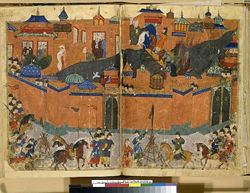
Cartoon of the Mongol siege of Baghdad in 1258
There are many differing views on the corporeality of destruction Genghis Khan and his armies acquired. The peoples who suffered the most during Genghis Khan'due south conquests, like the Persians and the Han Chinese, usually stress the negative aspects of the conquest and some modern scholars fence that their historians exaggerate the numbers of deaths. However, such historians produce near all the documents available to modern scholars and information technology is hard to plant a firm basis for whatsoever alternative view. Certainly, his legacy includes incidents of mass slaughter. Still, reverse to the popular European perception, it too includes unifying, under a stable and peaceful rule, a huge territory, in which merit could earn promotion and religious liberty was in the master upheld, at a time when such a affair was non-real in Europe.
The vast spread of the Mongolian Empire no dubiety is one of the significant contributing factors to the widespread distribution today of the Mongolian bluish spot, a birthmark actualization on the buttocks or back of young children[12] in what some have estimated to be more than than two-thirds of the human population.
Notes
- ↑ Leo de Hartog, Genghis Khan: Conqueror of the Earth (New York: Barnes and Noble, 1989). ISBN 0760711925), 12-thirteen.
- ↑ David Morgan, The Mongols (Oxford: Blackwell, 2006). ISBN 1405135395
- ↑ Rene Grousset, Conqueror of the World: The Life of Chingis-khan (New York: The Viking Printing, 1944).
- ↑ John Human being, Genghis Khan: Life, Expiry and Resurrection (New York: Bantam Press, 2004). ISBN 0593050444
- ↑ Igor de Rachewiltz, (tr.) The Hush-hush History of the Mongols: a Mongolian Ballsy Chronicle of the Thirteenth Century (Leiden: Brill Academic Publishers, 2004). ISBN 9004131590
- ↑ Paul Ratchnevsky, Genghis Khan: His Life and Legacy (Oxford: Blackwell, 1991). ISBN 0631189491
- ↑ Ratchnevsky, 136-137.
- ↑ Leo de Hartog, Genghis Khan: Conqueror of the World (New York: Barnes and Noble, 1989). ISBN 0760711925
- ↑ Hartog, forty.
- ↑ International Herald Tribune, Mongolia sees Genghis Khan's adept side. Retrieved October xv, 2007.
- ↑ Hartog, 146.
- ↑ Medline Plus, Mongolian blue spot. Retrieved September 7, 2007.
References
ISBN links support NWE through referral fees
- Bretschneider, Emilii. Mediæval Researches: From Eastern Asiatic Sources Fragments Towards the Knowledge of the Geography and History of Central and Western asia, 13th to the 17th Century. Munshiram Manoharial Publishers Private, Limited, 2000. ISBN 8121510031
- Charny, Israel Due west. (ed.). Genocide: A Disquisitional Bibliographic Review. New York, NY: Facts on File Publications, 1988-1994. ISBN 0816019037
- de Hartog, Leo. Genghis Khan: Conqueror of the World. New York, NY: Barnes and Noble, 1989. ISBN 0760711925
- de Rachewiltz, Igor (tr.) The Clandestine History of the Mongols: A Mongolian Ballsy Relate of the Thirteenth Century. Leiden: Brill Bookish Publishers, 2004. ISBN 9004131590
- Grousset, Rene. Conqueror of the World: The Life of Chingis-khan. New York, NY: Penguin Books, 1972. ISBN 978-0670003433
- Kahn, Paul (ed). Secret History of the Mongols: The Origin of Chingis Khan (expanded edition). Boston, MA: Cheng & Tsui Asian Culture Series, 1998. ISBN 0887272991
- Kennedy, Hugh. Mongols, Huns & Vikings. London: Cassell, 2002. ISBN 0304352926
- Lister, Richard Percival. Genghis Khan. New York, NY: Cooper Square Press, 2000. ISBN 0815410522
- Man, John. Genghis Khan: Life, Expiry and Resurrection. New York, NY: Bantam Press, 2004. ISBN 0593050444
- Morgan, David. The Mongols. Oxford: Blackwell, 2006. ISBN 1405135395
- Ratchnevsky, Paul. Genghis Khan: His Life and Legacy. Oxford: Blackwell, 1991. ISBN 0631189491
- Saunders, John Joseph. The History of the Mongol Conquests. Philadelphia, PA: University of Pennsylvania Press, 2001. ISBN 0812217667
- Stewart, Stanley. In the Empire of Genghis Khan: A Journeying among Nomads. Guilford, CT: Lyons Press, 2002. ISBN 1585747033
- Valentino, Benjamin A. Terminal Solutions: Mass Killing and Genocide in the Twentieth Century. Ithaca, NY: Cornell University Press, 2004. ISBN 0801439655
- Weatherford, Jack McIver. Genghis Khan and the Making of the Modernistic Earth. New York, NY: Crown, 2004. ISBN 0609610627
- Zerjal, Tatiana, et al. "The Genetic Legacy of the Mongols." The American Journal of Human being Genetics 2003: 717-721. Retrieved April 27, 2012.
External links
All links retrieved May 26, 2017.
- Genghis Khan In Our Time BBC Radio 4.
- Genghis Khan and the Great Mongol Empire.
- Welcome to The Realm of the Mongols.
- Estimates of Mongol warfare casualties.
Credits
New Globe Encyclopedia writers and editors rewrote and completed the Wikipedia article in accord with New World Encyclopedia standards. This commodity abides by terms of the Creative Commons CC-by-sa 3.0 License (CC-by-sa), which may be used and disseminated with proper attribution. Credit is due under the terms of this license that can reference both the New World Encyclopedia contributors and the selfless volunteer contributors of the Wikimedia Foundation. To cite this commodity click hither for a list of acceptable citing formats.The history of before contributions by wikipedians is accessible to researchers hither:
- Genghis Khan history
The history of this article since it was imported to New World Encyclopedia:
- History of "Genghis Khan"
Note: Some restrictions may apply to employ of private images which are separately licensed.
Source: https://www.newworldencyclopedia.org/entry/Genghis_Khan
0 Response to "Genghis Khan Never Question His Loyalty Again"
Post a Comment